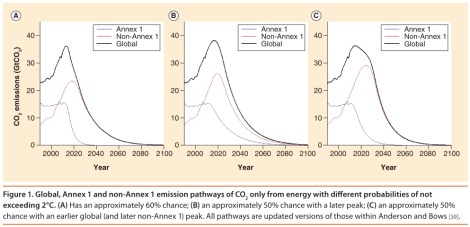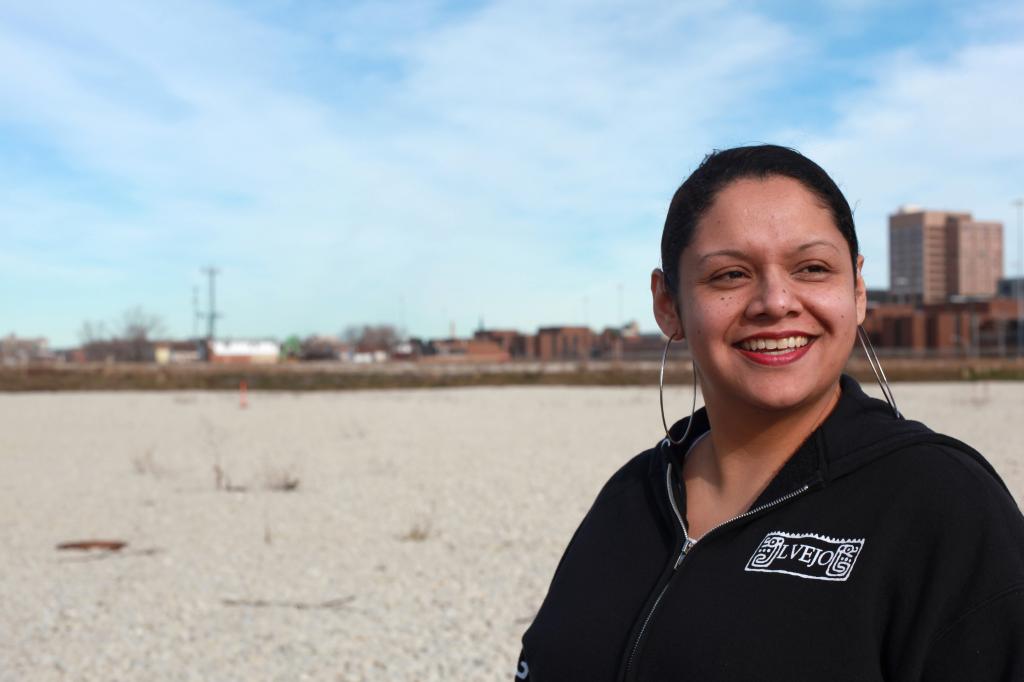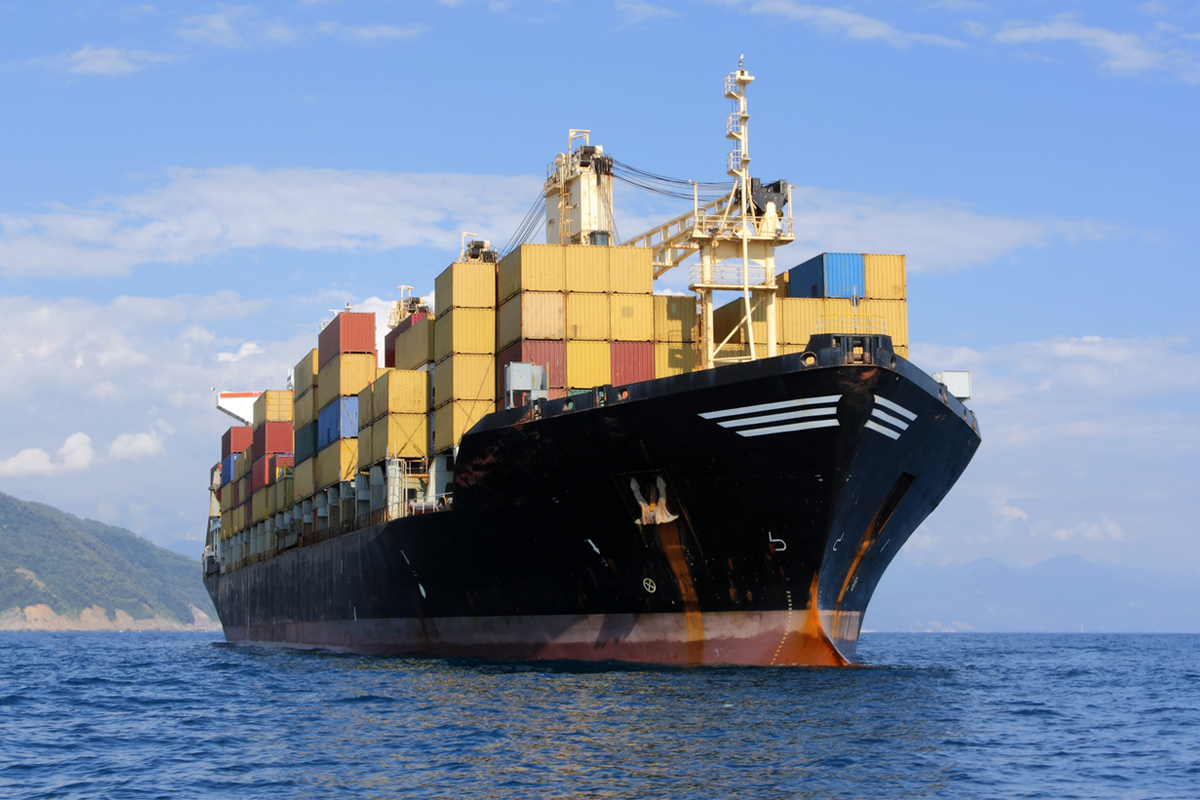There is a titanic gulf between what we say ought to be done about climate change and what we are doing. This ineluctable fact has loomed behind national and international policymaking for decades, but it is getting harder and harder to ignore.
Here’s what we say ought to be done: Article 2 of the 1992 United Nations Framework Convention on Climate Change (UNFCCC), to which 194 countries are party (including the United States), commits to “stabilization of [greenhouse gas] concentrations in the atmosphere at a level that would prevent dangerous anthropogenic interference with the climate system.” In 2009, the international community got more specific. The Copenhagen Accord, with which over 140 countries have engaged (including the United States), representing more than 87 percent of global emissions, says that the countries of the world should “hold the increase in global temperature below 2°C, and take action to meet this objective consistent with science and on the basis of equity.”
What would it mean to hold the increase in global temperature below 2°C? Unfortunately, models do not offer definitive answers to such questions. All they produce are likelihoods. An emissions pathway that yields a high (90 percent-plus) probability of holding temperatures to 2°C is almost certainly beyond our grasp at this point. Achieving even a 50/50 chance at holding to 2°C would require heroic measures — peaking global emissions before 2020 and reducing them rapidly every year thereafter.
[grist-related tag=”brutal-logic” limit=”4″]
To do so “on the basis of equity” means allowing developing nations (Non-Annex 1 countries, in U.N. lingo) a somewhat longer window in which to peak and begin reducing emissions. After all, developed (Annex 1) nations had the luxury of cheap fossil fuels as they developed and are responsible for the bulk of historical emissions.
So let’s take a look at those emission pathways. In the graphic below, the graph on the left shows the pathway that would offer a 60 percent chance of holding temps to 2°C. The one in the middle shows at 50 percent chance. The one on the right shows a 50 percent chance, but with “more equity,” i.e., more time for non-Annex 1 nations to hit the peak. Observe:

Anderson & BowsClick to embiggen.
This is from the work of climate scientists Kevin Anderson and Alice Bows, which was introduced in a paper called “Beyond ‘dangerous’ climate change: emission scenarios for a new world” [PDF]. I wrote a post about this in late 2011 called “the brutal logic of climate change.”
Needless to say, we are not acting in a fashion that would put us on any of those emission curves. According to International Energy Agency chief economist Fatih Birol, our current trajectory is “perfectly in line with a temperature increase of 6°C, which would have devastating consequences for the planet.”
In a more recent paper, Anderson and Bows try to make this gulf between stated intentions and actions more obvious by focusing on a single economic sector: the international shipping industry.
The industry is an interesting test case. Most global industries face a patchwork of national laws and regulations, but the agency that governs international shipping, the International Maritime Organization (IMO), has argued strongly that the industry should be governed by a single regulatory regime, as though it were a sovereign nation of its own. So this is a case where the international community’s intentions could theoretically be translated directly to action, without national governments as intermediaries. The IMO has said that the industry “will make its fair and proportionate contribution” to international mitigation efforts. (Shipping is responsible for about 3 percent of global emissions.)
The trade association for merchant ship operators, the International Chamber of Shipping (ICS), has said that the industry’s efforts will “be at least as ambitious” as UNFCCC targets.
So here we have an industry that has pledged in strong terms to do what is necessary to hold global temperature rise to 2°C, and a governing regulatory body that has pledged the same. So what’s actually happening?
The IMO’s two big mitigation efforts are Energy Efficiency Design Index (EEDI) and the Ship Energy Efficiency Management Plan (SEEMP). I won’t bore you with the details of those programs; we’ll skip to the part where Anderson and Bows show us how they stack up against the the reductions the industry would need to make if it were serious about 2°C.
In the graphic below, the graph on the left is three scenarios that represent international shipping doing its “fair and proportionate” share to reduce emissions. The graph on the right shows those scenarios compared to the emissions curves charted by the IMO’s policies:

Anderson & BowsClick to embiggen.
You don’t have to be a scientist to note that the scenario lines go down and the industry’s lines go up. In fact, note Anderson and Bows, “the shipping industry’s EEDI and SEEMP leave the sector on a trajectory for emissions to be approximately 2200% higher by 2050 than is their fair and proportionate contribution.”
Let that sink in for a moment: 2,200 percent. That’s the size of the gulf between the industry’s stated intentions and the industry’s real-world policies, between what it says it intends to do and what it’s doing. Anderson and Bows call this a “Machiavellian duality,” and it is by no means unique to shipping. It is true of most industries and most countries. We talk a good game about 2°C, but nobody, anywhere, is doing close to what would be necessary to make it real.
To add a kind of surreal twist to all this, the industry talks constantly about the emission “reductions” it plans. How can it do this when, as the graph makes clear, it plans enormous emission increases? What enables this kind of Orwellian doublespeak?
The answer is that the reductions are relative to a baseline projection of growth. They’re lower than they would be otherwise, without policy to reduce emissions. You hear this all the time, from companies, industries, agencies, and countries, about emission “reductions” that are, in fact, merely slightly-less-enormous emission increases. And so we lull ourselves with the thought that we’re doing something, making progress.
To point this out is not to counsel despair. It is merely to state the truth. Incremental policies will not do the job — what’s needed is fundamental changes, policies that halve emissions and then halve them again, over and over, until 2050. (If you’re interested in shipping particularly, Anderson and Bows list some of those step-wise policies at the end of their paper.) What is true for shipping is true for virtually all the world’s industries and countries. They say they want to avoid dangerous climate change. But they are barreling toward it, tweaking their emissions at the margins, hoping that at the end of the day there might be an A for effort. There won’t be.



